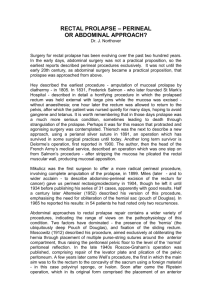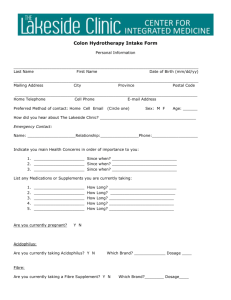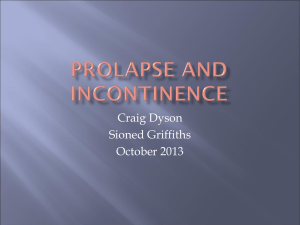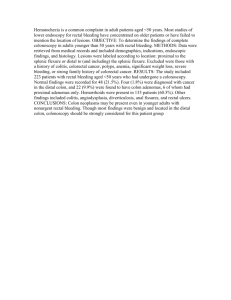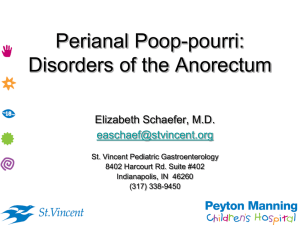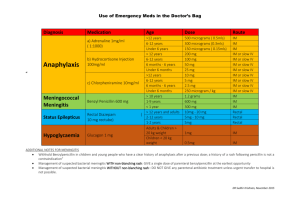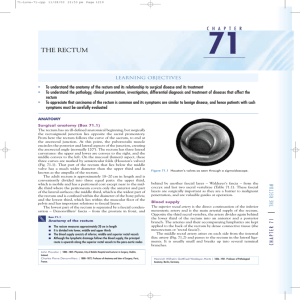Client Education - rectal prolapse
advertisement
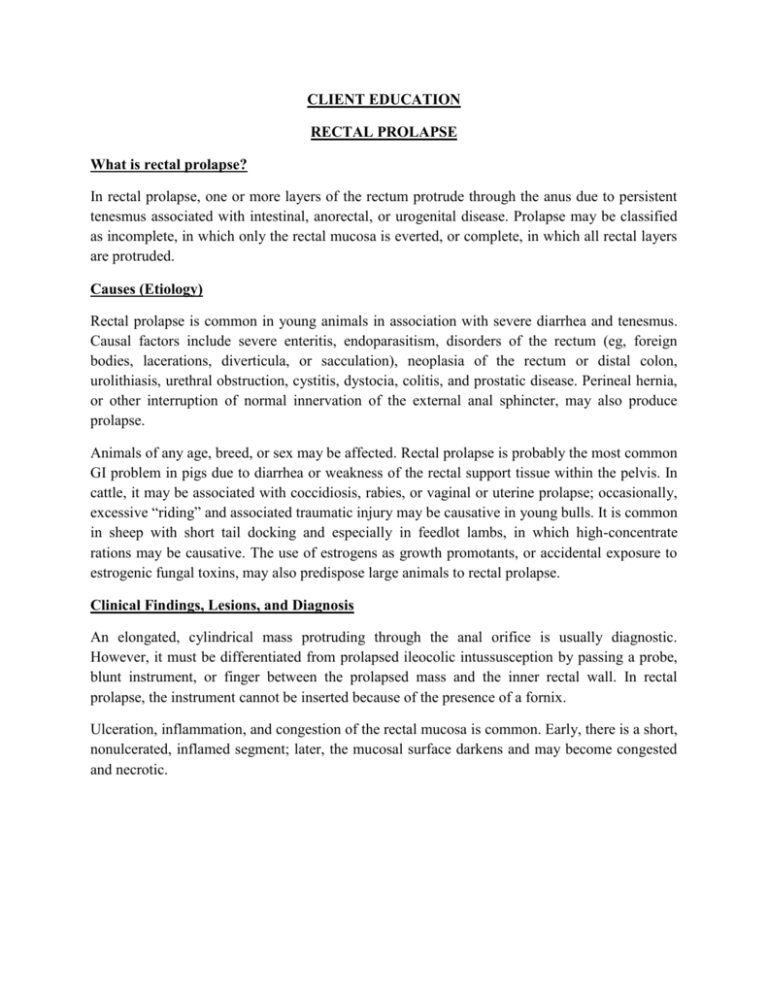
CLIENT EDUCATION RECTAL PROLAPSE What is rectal prolapse? In rectal prolapse, one or more layers of the rectum protrude through the anus due to persistent tenesmus associated with intestinal, anorectal, or urogenital disease. Prolapse may be classified as incomplete, in which only the rectal mucosa is everted, or complete, in which all rectal layers are protruded. Causes (Etiology) Rectal prolapse is common in young animals in association with severe diarrhea and tenesmus. Causal factors include severe enteritis, endoparasitism, disorders of the rectum (eg, foreign bodies, lacerations, diverticula, or sacculation), neoplasia of the rectum or distal colon, urolithiasis, urethral obstruction, cystitis, dystocia, colitis, and prostatic disease. Perineal hernia, or other interruption of normal innervation of the external anal sphincter, may also produce prolapse. Animals of any age, breed, or sex may be affected. Rectal prolapse is probably the most common GI problem in pigs due to diarrhea or weakness of the rectal support tissue within the pelvis. In cattle, it may be associated with coccidiosis, rabies, or vaginal or uterine prolapse; occasionally, excessive “riding” and associated traumatic injury may be causative in young bulls. It is common in sheep with short tail docking and especially in feedlot lambs, in which high-concentrate rations may be causative. The use of estrogens as growth promotants, or accidental exposure to estrogenic fungal toxins, may also predispose large animals to rectal prolapse. Clinical Findings, Lesions, and Diagnosis An elongated, cylindrical mass protruding through the anal orifice is usually diagnostic. However, it must be differentiated from prolapsed ileocolic intussusception by passing a probe, blunt instrument, or finger between the prolapsed mass and the inner rectal wall. In rectal prolapse, the instrument cannot be inserted because of the presence of a fornix. Ulceration, inflammation, and congestion of the rectal mucosa is common. Early, there is a short, nonulcerated, inflamed segment; later, the mucosal surface darkens and may become congested and necrotic. Treatment In all animals, identifying and eliminating the cause of prolapse is of primary importance. In small animals, treatment includes prompt replacement of viable prolapsed tissue to its proper anatomic location, or amputation if the segment is necrotic. Small or incomplete prolapses can be manually reduced under anesthesia by using a finger or bougie. Warm saline lavage and lubrication with a water-soluble gel should be applied to the prolapsed tissue before reduction. Alternatively, hypertonic sugar solution (50% dextrose or 70% mannitol) applied topically may be used to relieve edematous mucosa. The placement of a loose, anal purse-string suture for 5–7 days is indicated. Straining may be prevented by applying a topical anesthetic (1% dibucaine ointment) or by administering a narcotic epidural injection before or after reduction or correction. Postoperatively, a moistened diet and a fecal softener (eg, dioctyl sodium sulfosuccinate) are recommended. Diarrhea after surgery may require treatment. When questionable viability of tissue prohibits manual reduction, rectal resection and anastomosis are required. When rectal tissue is viable but not amenable to manual reduction, celiotomy followed by colopexy is indicated to prevent recurrence. As in medical management, epidural anesthesia may be used to reduce straining. In large animals, caudal epidural anesthesia is suggested to reduce straining, facilitate repositioning of the prolapse, and permit surgical manipulations. Reduction and retention with a purse-string suture is recommended. The suture should be loose enough to leave a one-finger opening into the rectum in pigs and sheep, and slightly larger in cattle and horses. Rectal prolapse in mares, if neglected, can lead to prolapse of the small colon. The blood supply to the small colon is easily disrupted. Replacement of a rectal prolapse with prolapse of the small colon followed by purse-string suture of the anus has a poor prognosis. More aggressive treatment of the prolapse is dictated by the condition of the rectum. In general, the prolapse may be salvaged by conservative measures, unless obvious deep necrosis or trauma to the tissue exists, or the everted tissue is firm, indurated, and cannot be reduced. Under these circumstances, submucosal resection or amputation should be considered. Amputation of the rectum should be reserved for severe cases. Complete amputation has a higher incidence of rectal stricture formation, especially in swine. A prolapse ring, syringe case, or plastic tubing may be used as an alternative to surgical amputation in pigs and sheep. Postoperatively, the animal should receive antibiotics. Fecal softeners may be used in horses. Usually, it is not economically feasible to repair rectal prolapses in lambs ready for market.


